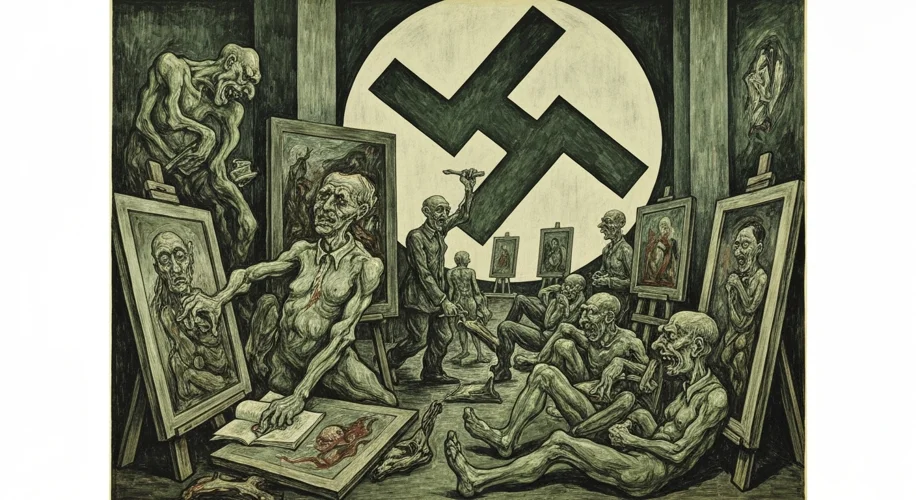The year is 1937. In the heart of Nazi Germany, a grand exhibition opens its doors, not to celebrate artistic achievement, but to revile it. Titled “Entartete Kunst”—Degenerate Art—it showcased a curated collection of modern masterpieces, twisted and defaced, presented as the spawn of madness and racial impurity. This was no mere display of poor taste; it was a calculated assault on the very soul of artistic expression, a chilling glimpse into an ideology that simultaneously condemned abstract thought while embracing its own stark, simplified symbolism.
For years leading up to this infamous exhibition, the Nazi regime had been systematically purging art galleries and museums across Germany. Masters like Picasso, Matisse, Kandinsky, and Klee, once revered, were now deemed enemies of the state. Their works, characterized by bold colors, distorted forms, and subjective interpretations, were labeled “degenerate” – a term loaded with connotations of mental illness, Jewish influence, and a rejection of traditional German values. Adolf Hitler himself famously abhorred modern art, viewing it as a decadent product of a society he sought to eradicate.

The “Degenerate Art” exhibition was the culmination of this cultural cleansing. Visitors were confronted with paintings slashed and scribbled on, sculptures disfigured, and artworks deliberately hung in a chaotic, mocking manner. The accompanying text and audio guides spewed propaganda, attempting to link artistic innovation with political subversion and racial inferiority. It was a visceral experience designed to shock and disgust, to alienate the public from the avant-garde and solidify the regime’s vision of what constituted “true” German art: heroic, realistic, and nationalistic.
But here lies a profound paradox. While the Nazis vehemently denounced the perceived complexity and abstraction of modern art, their own propaganda and visual culture were deeply steeped in simple, potent, and often abstract symbolism. The swastika, the eagle, the torchlight parades, the stark geometric patterns of propaganda posters—these were all forms of visual communication that relied on immediate, often unthinking, emotional impact. They stripped away nuance, favored bold declarative statements, and sought to create a unified, uncritical national consciousness.
Consider the ubiquitous swastika. It is a powerful, abstract symbol, stripped of intricate meaning and designed for instant recognition and emotional response. Its stark angularity and repetition were meant to evoke a sense of order, power, and racial purity. Compare this to the swirling, emotive brushstrokes of a Kandinsky or the fragmented realities of a Picasso. While both are forms of visual language, the Nazis championed the former while demonizing the latter, revealing a deep-seated fear of anything that encouraged individual interpretation or challenged their monolithic worldview.
This selective embrace of symbolism speaks volumes about Nazi ideology. It was not a rejection of abstraction itself, but a rejection of abstraction that was perceived as foreign, individualistic, or intellectually challenging. The art they approved of—often called “Blood and Soil” art—was didactic and nationalistic, meant to reinforce their racist pseudoscience and glorify the state. The “degenerate” art, by contrast, represented a world of individual freedom, critical thinking, and emotional complexity—qualities an authoritarian regime could not tolerate.
The consequences of this cultural war were devastating. Thousands of artworks were confiscated and either destroyed or sold abroad to fund the regime. Many artists fled Germany, while others were persecuted, imprisoned, or murdered. The vibrant cultural landscape of the Weimar Republic was brutally suppressed, leaving a void filled with sterile, state-sanctioned propaganda.
The “Degenerate Art” exhibition was not just an attack on paintings and sculptures; it was an attack on the freedom of thought and expression. The paradox of the Nazi regime’s simultaneous condemnation of modern art and their own embrace of simplistic, powerful symbolism highlights their fear of complexity, their desire for total control, and their attempt to manipulate visual culture to serve a dangerous political agenda. It serves as a stark reminder that art, in its myriad forms, can be a powerful tool for challenging established norms and fostering individual understanding—a threat to any regime that seeks to impose its will through ideological conformity.

